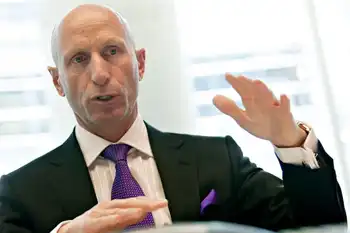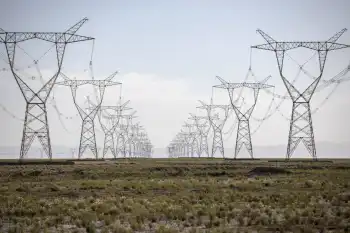Nuclear plant workers battle fire, radiation
By Toronto Star
Protective Relay Training - Basic
Our customized live online or in‑person group training can be delivered to your staff at your location.

- Live Online
- 12 hours Instructor-led
- Group Training Available
They crawl through labyrinths of equipment in utter darkness pierced only by their flashlights, listening for periodic explosions as hydrogen gas escaping from crippled reactors ignites on contact with air.
They breathe through uncomfortable respirators or carry heavy oxygen tanks on their backs. They wear white, full-body jumpsuits with snug-fitting hoods that provide scant protection from the invisible radiation sleeting through their bodies.
They are the faceless 50, the unnamed operators who stayed behind. They have volunteered, or been assigned, to pump seawater on dangerously exposed nuclear fuel, already thought to be partly melting and spewing radioactive material, to prevent full meltdowns that could throw thousands of tons of radioactive dust high into the air and imperil millions of their compatriots.
They struggled to keep hundreds of gallons of seawater a minute flowing through temporary fire pumps into the three stricken reactors, Nos. 1, 2 and 3.
Among the many problems that officials acknowledged was what appeared to be yet another fire at the plant and indications that the containment vessel surrounding a reactor may have ruptured. That reactor, No. 3, appeared to be releasing radioactive steam.
The workers are being asked to make escalating – and perhaps existential – sacrifices that so far are being only implicitly acknowledged: Japan’s Health Ministry said that it was raising the legal limit on the amount of radiation to which each worker could be exposed, to 250 millisieverts from 100 millisieverts, five times the maximum exposure permitted for nuclear plant workers in North America.
The change means that workers can now remain on site longer, the ministry said.
“It would be unthinkable to raise it further than that, considering the health of the workers,” the health minister, Yoko Komiyama, said at a news conference. There was also a suggestion on Wednesday that more workers may be brought to help save the power station.
Tokyo Electric Power Co., the plantÂ’s operator, has said almost nothing at all about the workers, including how long a worker is expected to endure exposure.
The few details Tokyo Electric has made available paint a dire picture.
Five workers have died since the quake and 22 more have been injured for various reasons, while two are missing. One worker was hospitalized after suddenly grasping his chest and finding himself unable to stand, and another needed treatment after receiving a blast of radiation near a damaged reactor.
Eleven workers were injured in a hydrogen explosion at reactor No. 3.
Nuclear reactor operators say that their profession is typified by the same kind of esprit de corps found among firefighters and elite military units. Lunchroom conversations at reactors frequently turn to what operators would do in a severe emergency.
The consensus is always that they would warn their families to flee before staying at their posts to the end, said Michael Friedlander, a former senior operator at three U.S. power plants for 13 years.
“You’re certainly worried about the health and safety of your family, but you have an obligation to stay at the facility,” he said. “There is a sense of loyalty and camaraderie when you’ve trained with guys, you’ve done shifts with them for years.”
Adding to this natural bonding, jobs in Japan confer identity, command loyalty and inspire a particularly fervent kind of dedication.
Economic straits have chipped away at the hallowed idea of lifetime employment for many Japanese, but the workplace remains a potent source of community.
Friedlander said that he had no doubt that in an identical accident in the United States, 50 volunteers could be found to stay behind after everyone else evacuated from an extremely hazardous environment. But Japanese are raised to believe that individuals sacrifice for the good of the group.
The reactor operators face extraordinary risks.
Tokyo Electric evacuated 750 emergency staff members from the stricken plant, leaving only about 50, when radiation levels soared. By comparison, standard staffing levels at the three active General Electric reactors on the site would be 10 to 12 people apiece including supervisors – an indication that the small crew left behind is barely larger than the contingent on duty on a quiet day.
Daiichi is not synonymous with Chernobyl in terms of the severity of contamination. The Ukrainian reactor blew up and spewed huge amounts of radiation for 10 days in 1986. But workers at the plants have a bond.
Among plant employees and firefighters at Chernobyl, many volunteered to try to tame, and then entomb, the burning reactor – although it is not clear that all were told the truth about the risks.
Within three months, 28 of them died from radiation exposure. At least 19 of them were killed by infections that resulted from having large areas of their skin burned off by radiation, according to a recent report by a UN scientific committee. And 106 others developed radiation sickness, with nausea, vomiting, diarrhea and dropping blood counts that left them highly vulnerable to infections.
The people who had suffered radiation sickness developed other problems later, according to the report: cataracts, severe scarring from the radiation burns to their skin and an increased number of deaths from leukemia and other blood cancers.
Some of those Chernobyl workers were exposed to levels of radiation far beyond what has been measured to date at Daiichi – especially pilots of helicopters who flew through radiation-laden smoke spewing from the reactor to try to drop fire-extinguishing chemicals on it.
Radiation close to the reactors was reported to reach 400 millisieverts per hour March 15 after a blast inside reactor No. 2 and fire at reactor No. 4, but has since dropped back to as low as 0.6 millisieverts at the plant gate.
Tokyo Electric and Japanese regulators have not released any statistics on radiation levels inside the containment buildings where engineers are desperately trying to fix electrical systems, pumps and other gear wrecked by the earthquake and tsunami.
But nuclear experts said that indoor radiation levels are likely to be higher because the containment buildings are probably still preventing most radiation from leaving the power plant.
The site is now so contaminated with radiation, experts say, that it has become difficult for employees to work near the reactors for extended periods of time. According to one expertÂ’s account of nuclear emergency procedures, workers would be cycled in and out of the worst-hit parts of the plant.
In some cases, when dealing with a task in a highly radioactive area of the plant, workers might line up and handle the task only for minutes at a time before passing off to the next worker, said Katsuhiko Ishibashi, a former professor in the Research Center for Urban Safety and Security at Kobe University.
Tokyo Electric has refused to release the names or any other information about the workers who stayed behind, nor have utility executives said anything about how the 50 are being relieved as they become tired or ill.
Some of those battling flames and spraying water at reactors at Daiichi are members of JapanÂ’s Self-Defence Force, police officers or firefighters. Others are contractors sent to the plant.
Defence Minister Toshimi Kitazawa said that Self-Defence Force soldiers might be called on to fly the helicopters that Tokyo Electric may use to spray water onto the overheating used fuel storage pool at reactor No. 4.
The same day, however, members of JapanÂ’s nuclear watchdog group, who had been stationed about five kilometres from the plant, were moved to a site 25 kilometres away. Authorities later said that using helicopters to put spray water on reactor No. 4 might not be feasible.
If the plant operator is strictly limiting the exposure of each worker at Daiichi – and thus calling on hundreds of volunteers to make up the 50 on site at any given time – then Chernobyl may offer some consolation.
To clean up the Chernobyl site after the accident, the Soviet Union conscripted workers in proportion to the size of each of its republics, and developed a system to limit their exposure.
“They sent up to 600,000 people in to clean up the radioactive debris around the plant and build a sarcophagus,” said Dr. John Boice, an author of the study, a professor of medicine at Vanderbilt and the scientific director of the International Epidemiology Institute in Rockvillle, Md.
The workers, known as “liquidators,” were sent into contaminated zones for limited periods.
“To date there’s very little evidence for adverse effects,” Boice said. “It was pretty smart. A large number of people got a relatively small dose. There may be a small risk of leukemia, but that’s not conclusive.”











